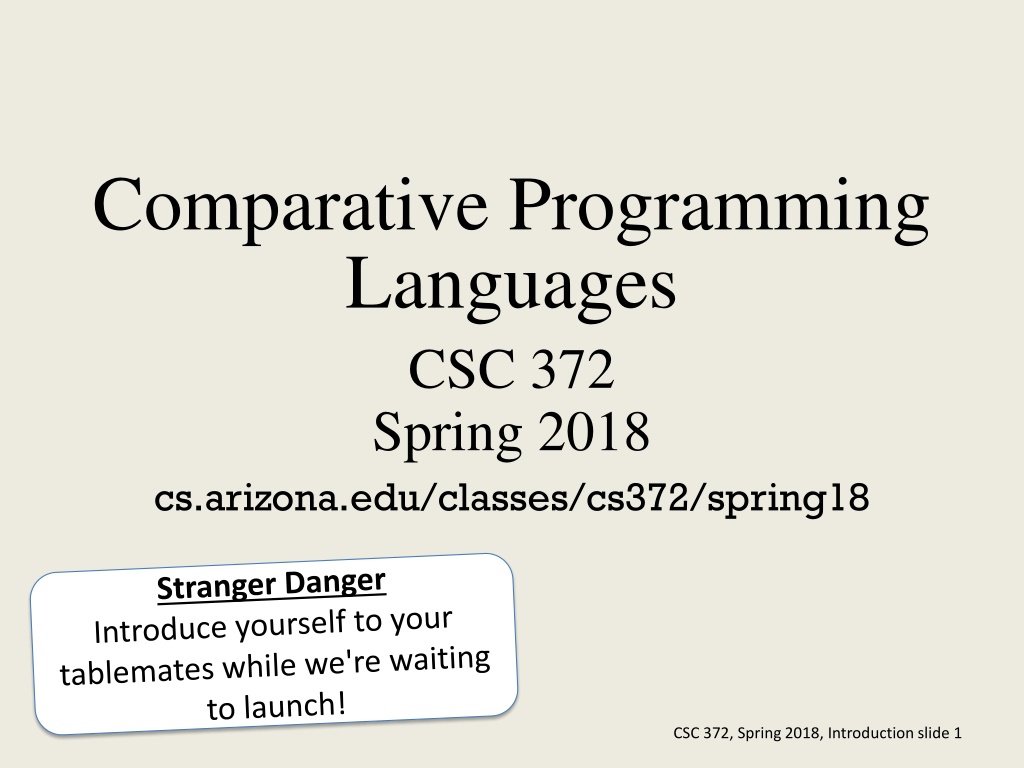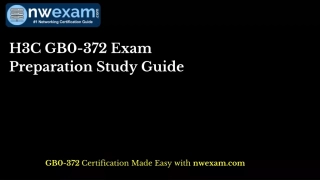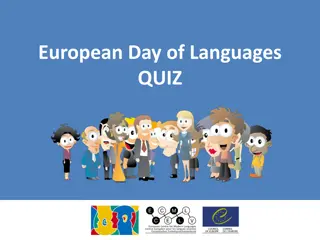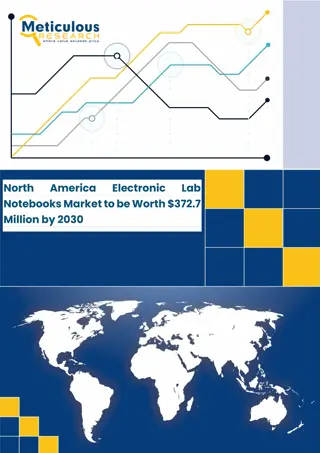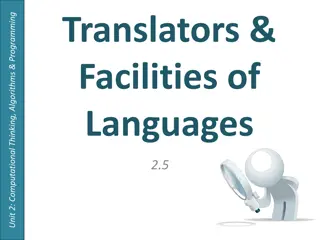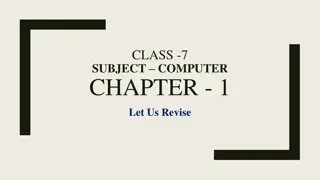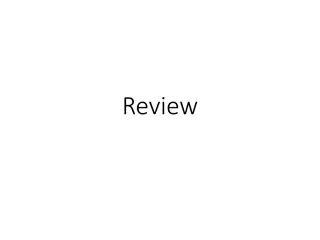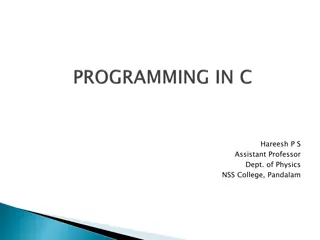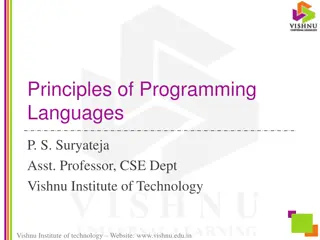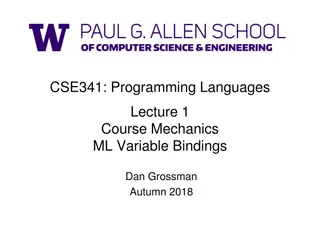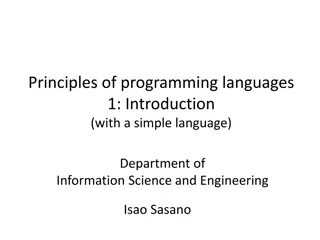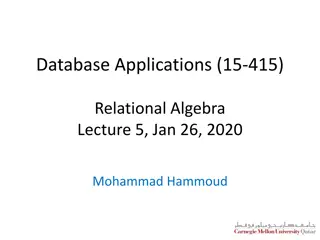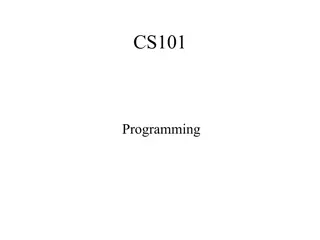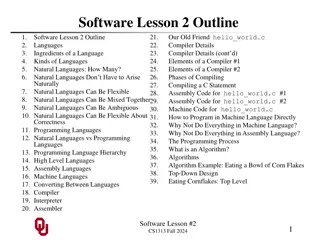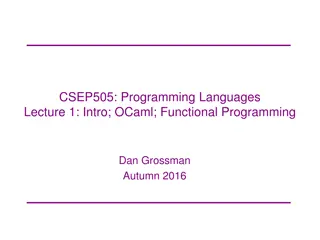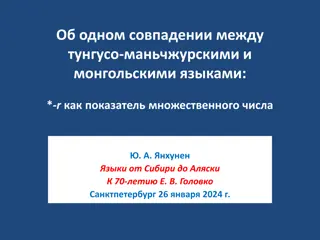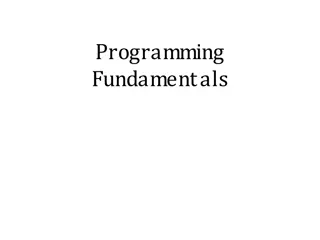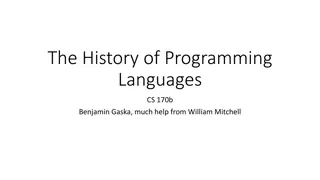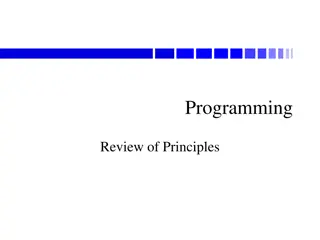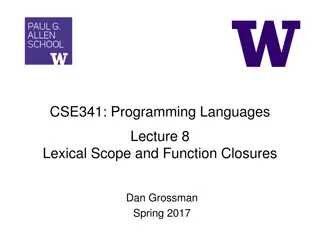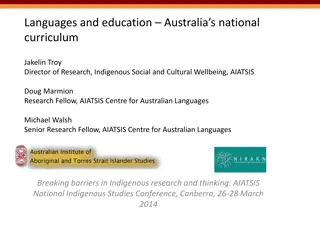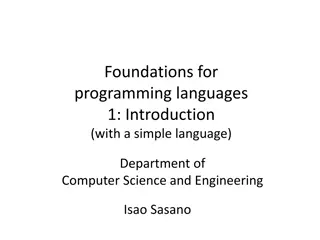Comparative Programming Languages - CSC 372 Spring 2018 Introduction
In the domain of computer science, the course CSC 372 for Spring 2018 delves into the realm of programming languages. The slides provide an insightful introduction to comparative analysis of different programming languages, shedding light on their unique features, structures, and functionalities. By studying this course, students gain a comprehensive understanding of the significance and application of various programming languages in the modern technological landscape.
Download Presentation

Please find below an Image/Link to download the presentation.
The content on the website is provided AS IS for your information and personal use only. It may not be sold, licensed, or shared on other websites without obtaining consent from the author.If you encounter any issues during the download, it is possible that the publisher has removed the file from their server.
You are allowed to download the files provided on this website for personal or commercial use, subject to the condition that they are used lawfully. All files are the property of their respective owners.
The content on the website is provided AS IS for your information and personal use only. It may not be sold, licensed, or shared on other websites without obtaining consent from the author.
E N D
Presentation Transcript
Comparative Programming Languages CSC 372 Spring 2018 cs.arizona.edu/classes/cs372/spring18 CSC 372, Spring 2018, Introduction slide 1
Instructor William Mitchell (whm) Consultant/contractor doing software development and training of software developers. Lots with Java, C++, C, Python, Ruby, Icon, and more. Linux stuff, too. Occasionally teach a CS course. (337, 352, 372, and others) Adjunct instructor, not a professor Education: BS CS (North Carolina State University, 1981) MS CS (University of Arizona, 1984) Incorrect to say "Dr. Mitchell" or "Professor Mitchell"! CSC 372, Spring 2018, Introduction slide 2
Topic Sequence Functional programming with Haskell Imperative and object-oriented programming using dynamic typing with Ruby Logic programming with Prolog Whatever else in the realm of programming languages that we find interesting and have time for. Note: We'll cover a selection of elements from the languages, not everything. CSC 372, Spring 2018, Introduction slide 3
Themes running through the course Discerning the philosophy of a language and how it's manifested Understanding tensions and tradeoffs in language design Acquiring a critical eye for language design Assessing the "mental footprint" of a language Learning how to learn a language (LHtLaL) CSC 372, Spring 2018, Introduction slide 4
Syllabus highlights (cs.arizona.edu/classes/cs372/spring18/syllabus.html) CSC 372, Spring 2018, Introduction slide 5
Prereqs, Piazza, Mail Prerequisites CSC 120 or 127B or 227 But, this is a 300-level class! Piazza Our forum Sign up if you haven't already! Private posts disabled use mail If staff starts a thread, the first post is required reading Mail goes to whm and TAs For anything more than "Thanks!" use "Reply All" to follow the Cc:'s CSC 372, Spring 2018, Introduction slide 6
Teaching Assistants Undergraduate TAs Alex Koltz (akoltz) Michael Ordaz (michaelaordaz) Office hours and contact information is on website CSC 372, Spring 2018, Introduction slide 7
Textbooks No texts are required. Lectures, handouts, and Piazza postings might be all you need. Syllabus and slides have recommendations for supplementary texts, most of which are on Safari Books Online. Suggested supplementary readings will be provided (but alignment with our topics and sequencing is tough) CSC 372, Spring 2018, Introduction slide 8
Handouts Handouts of all slides will be provided Three options for handouts with slides: Handouts with selected questions answered Handouts with selected questions unanswered (default) No handouts Mail us to adjust your preference Both versions, as both PDFs and .pptxs, on website CSC 372, Spring 2018, Introduction slide 9
Grading Grading Assignments Pop quizzes Mid-term exam Final exam 5% 13% 22% 60% Ten-point scale: >= 90 is A, etc. Might go lower. Original Thoughts Half-point on final average for each CSC 372, Spring 2018, Introduction slide 10
Assignments Assignments things like: Coding in the various languages Short answer and essay questions Diagrams One video project Late assignments are not accepted! No late days! But, extensions for situations beyond your control. CSC 372, Spring 2018, Introduction slide 11
Collaborative Learning Exercises "Collaborative learning is two or more students laboring together and sharing the workload equitably as they progress toward intended learning outcomes." Barkley et al. This is my first use of CLEs. I welcome your feedback! Exercises typically done during the class period Group size will vary; groups formed in various ways Exercises will be graded Scores will be grouped with assignment points CSC 372, Spring 2018, Introduction slide 12
We'll be grading on lectura You can develop solutions on your own machines but they'll be graded on the CS machine "lectura", and thus should be tested there. Mail us (372s18@cs) TODAY if you haven't worked on lectura or if you feel your knowledge of that eviroment is weak; we'll be happy to help you get up and running there. If you haven't had 352, I recommend you skim through my UNIX slides: http://cs.arizona.edu/classes/cs352/fall15/unix.pdf CSC 372, Spring 2018, Introduction slide 13
Office hours I love office hours! Website has guaranteed hours Open-door policy otherwise In-person interaction is most effective Discord or Skype preferred for IM and screen sharing OK to call my mobile but don't leave voice mail! (Send e-mail instead.) CSC 372, Spring 2018, Introduction slide 14
Suggestions for success Attend every lecture. Arrive on time for lectures. Work through all examples on the slides. Try some what-ifs, too. Read the write-up for an assignment the day it's handed out. Start on assignments early. Don't be a regular in the Thursday Night Club. Don't leave any points on the table. Don't hesitate to ask for help on an assignment. If you get behind, come to office hours right then! Don't make bad assumptions. CSC 372, Spring 2018, Introduction slide 15
NO CHEATING! NO CHEATING! Capsule summary: Don't cheat in my class! Don't make it easy for anybody else to cheat! One strike and you're out! For a first offense expect these penalties: Failing grade for course Permanent transcript annotation Recommendation for one semester university suspension A typical first step on the road to ruin is sharing your solutions with your best friend, roommate, etc., who swears to just learn from your work and absolutely not turn it in as their work. CSC 372, Spring 2018, Introduction slide 16
No asking the world for help! The material covered in lectures, posted on Piazza, etc. should be all you need to do the assignments. I challenge you to not search the web for solutions for problems on assignments! Posting problem-specific questions on websites, IRC channels, mailing lists, etc. will be considered to be cheating! Example: I'm learning Haskell and trying to write a function that returns True iff the parentheses in a string are properly matched. Any suggestions? CSC 372, Spring 2018, Introduction slide 17
My Teaching Philosophy I work for you! My goal: everybody earns an "A" and averages less than ten hours per week on this course, counting lecture time. Effective use of office hours, e-mail, and IM can equalize differences in learning speed. I should be able to answer every pertinent question about course material. My goal is zero defects in slides, assignments, etc. Bug Bounty: One assignment point Everything I'll expect you to know on exams will be covered in class, on assignments, or on Piazza. CSC 372, Spring 2018, Introduction slide 18
READ THE SYLLABUS! (cs.arizona.edu/classes/cs372/spring18/syllabus.html) CSC 372, Spring 2018, Introduction slide 19
Assignment 1 and 2 Assignment 1 It's a survey (on the class website) Due Sunday, January 14, 11:00pm Worth 10 points Maybe 10 minutes to complete Thanks for doing it! Assignment 2 On the website Due Sunday, January 21 at 11:00pm CSC 372, Spring 2018, Introduction slide 20
Pictures & Name memorization CSC 372, Spring 2018, Introduction slide 21
Basic questions about programming languages CSC 372, Spring 2018, Introduction slide 22
What is a programming language? A simple definition: A system of rules for data manipulation. It is generally agreed that in order for a language to be considered a programming language it must be Turing Complete. One way to prove a language is Turing Complete is to use it to implement a Universal Turing Machine, a theoretical device capable of performing any algorithmic computation. What language is most commonly mis-listed on resumes as a programming language? CSC 372, Spring 2018, Introduction slide 23
Does it matter what language is used? The two extremes: If you ve seen one language, you ve seen them all. Just pick one and get to work. Nothing impacts software development so much as the language being used. We must choose very carefully! CSC 372, Spring 2018, Introduction slide 24
Why study programming languages? Learn new ways to think about computation Learn to see languages from a critical viewpoint Improve basis for choosing languages for a task Add some tools to the toolbox Increase ability to design a new language "A programmer should learn a new language every year." --Recommended in The Pragmatic Programmer CSC 372, Spring 2018, Introduction slide 25
How old are programming languages? Prolog 1972 Smalltalk 1972 ML 1977 Icon 1979 Ada 1980 C++ 1983 Objective-C 1983 Erlang 1986 Perl 1987 Haskell 1990 Python 1991 Ruby 2/24/93 Java 1995 JavaScript 1995 PHP 3 1998 C# 2000 D 2001 Scala 2003 Clojure 2007 Go 2008 Rust 2010 Kotlin 2011 TypeScript 2012 Julia 2012 Swift 2014 Goaldi 2015 Plankalk l 1945 Short Code 1949 FORTRAN 1957 ALGOL 1958 LISP 1958 COBOL 1959 BASIC 1964 PL/I 1965 SNOBOL4 1967 SIMULA 67 1967 Pascal 1971 C 1972 CSC 372, Spring 2018, Introduction slide 26
How many languages are there? The State of the Octoverse 2017 (octoverse.github.com) wikipedia.org/wiki/Alphabetical_list_of_programming_languages The Language List people.ku.edu/~nkinners/LangList/Extras/langlist.htm Online Historical Encyclopaedia of Programming Languages hopl.info CSC 372, Spring 2018, Introduction slide 27
How are languages related to each other? Some of the many attempts at a family tree of languages: digibarn.com/collections/posters/tongues levenez.com/lang rigaux.org/language-study/diagram.html www.seas.gwu.edu/~mmburke/courses/csci210- su10/tester-endo.pdf (Seems to be based on hopl.info data.) CSC 372, Spring 2018, Introduction slide 28
Collaborative Learning Exercise What languages are popular right now? cs.arizona.edu/classes/cs372/spring18/cle-poplang.html CSC 372, Spring 2018, Introduction slide 29
How do languages help us? Free the programmer from details int i = 5; x = y + z * q; Detect careless errors int f(String s, char c); ... int i = f('i', "Testing"); Provide constructs to concisely express a computation for (int i = 1; i <= 10; i++) ... CSC 372, Spring 2018, Introduction slide 30
How languages help, continued Provide portability Examples: C provides moderate source-level portability. Java was designed with binary portability in mind. Facilitate using a paradigm, such as functional, object- oriented, or logic programming. CSC 372, Spring 2018, Introduction slide 31
How are languages specified? The specification of a language has two key aspects: Syntax Specifies the sequences of symbols that are valid programs in the language. Semantics Specifies the meaning of a sequence of symbols. Language specifications fall on a broad spectrum: High end: The specification is a published international standard Low end: The behavior of the lone implementation is the specification. CSC 372, Spring 2018, Introduction slide 32
Syntax vs. semantics Consider this expression: a[i] = x What are some languages in which it is syntactically valid? In each of those languages, what is the meaning of it? What are various meanings for these expressions? x || y x y *x CSC 372, Spring 2018, Introduction slide 33
Building blocks What are the building blocks of a language? Data types Operators Control structures Support for encapsulation Functions Abstract types / Classes Packages / Modules Error / Exception handling Standard library CSC 372, Spring 2018, Introduction slide 34
What are qualities a language might have? Simplicity ( mental footprint ) Expressive power Readability of programs Orthogonality Extensibility Reliability of programs Run-time efficiency Practical development project size Support for a style of programming What are some tensions between these qualities? CSC 372, Spring 2018, Introduction slide 35
What factors affect popularity? Available implementations Documentation Community Vectors of infection Ability to occupy a niche Availability of supporting tools, like debuggers and IDEs Buzz Cost CSC 372, Spring 2018, Introduction slide 36
The philosophy of a language What is the philosophy of a language? How is it manifested? C Close to the machine Few constraints on the programmer High run-time efficiency What you write is what you get. C++ Close to both machine and problem being solved Support object-oriented programming As close to C as possible, but no closer. Stroustrup PostScript Page description Intended for generation by machines, not humans What is the philosophy of Java? CSC 372, Spring 2018, Introduction slide 37
A Little U of A CS History CSC 372, Spring 2018, Introduction slide 38
The Founding of UA CS The UA CS department was founded by Ralph Griswold in 1971. (Hint: know this! Mnemonic aid: ASCII 'G' is 71.) Griswold was Head of Programming Research and Development at Bell Labs before coming to UA. Griswold and his team at Bell Labs created the SNOBOL family of languages, culminating with SNOBOL4. Griswold's interest and prominence in programming languages naturally influenced the course of research at UA. CSC 372, Spring 2018, Introduction slide 39
UA CS's language heritage In the 1970s and 1980s UA Computer Science was recognized worldwide for its research in programming languages. These are some of the languages created here: Cg EZ Icon Leo MPD Ratsno Rebus Seque SIL2 SL5 SR SuccessoR Unicon Y Goaldi Along with language design, lots of work was focused on language implementation techniques. CSC 372, Spring 2018, Introduction slide 40
My intersection with Griswold's work I learned FORTRAN IV and BASIC in a summer school course at Wake Forest during the summer after high school. In first trip to library at NCSU, took home a stack of books on programming languages, including SNOBOL4. Was totally mystified. Learned PL/I in two-course introduction to computer science sequence. Took a one-unit course on SNOBOL4 during sophomore year. Used SPITBOL whenever possible in courses thereafter. Attended a colloquium at NCSU where Ralph Griswold presented a new programming language, named Icon. Ported Icon to an IBM mainframe and DEC's VAX/VMS. Went to graduate school here at UA, and worked on Icon as a graduate research assistant for Dr. Griswold. CSC 372, Spring 2018, Introduction slide 41
Quiz! CSC 372, Spring 2018, Introduction slide 42
